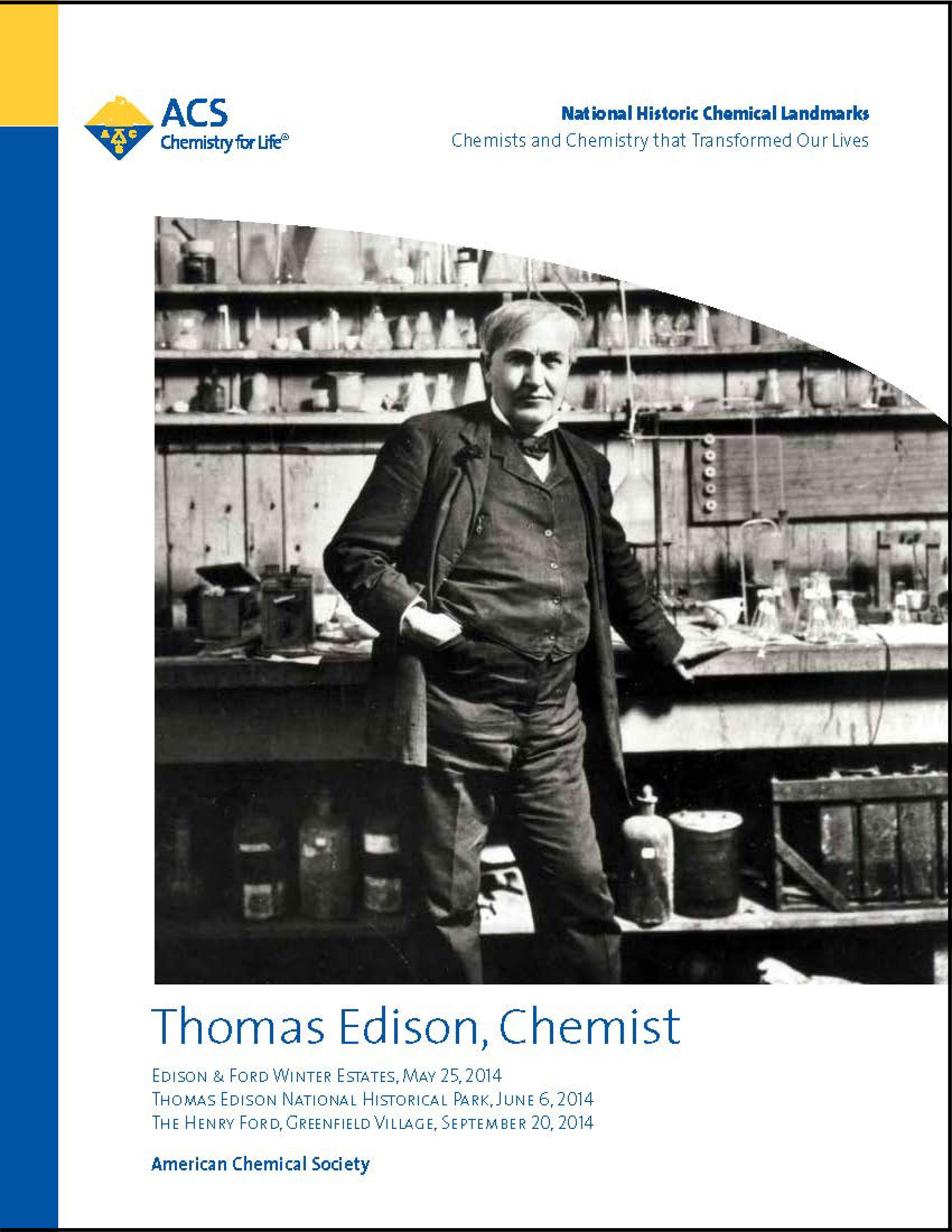Thomas Edison, Chemist
National Historic Chemical Landmark
Designated at the present sites of Edison's three research laboratories: the Edison & Ford Winter Estates in Fort Myers, Florida, on May 25, 2014; at the Thomas Edison National Historical Park in West Orange, New Jersey, on June 6, 2014; at the Menlo Park Laboratory at The Henry Ford, Greenfield Village, in Dearborn, Michigan, on September 20, 2014, and at the Thomas Edison Center at Menlo Park in Edison, New Jersey, on October 24, 2015.
Thomas Alva Edison is an unparalleled figure in the history of the United States. Born into a middle-class family in the American Midwest during the 1840s and with little formal education, Edison became a household name for his inventions that ushered in a new era of modernity with light and sound in every home. With more than 1,000 patents and inventions that inspired people throughout the nation, Edison was an able experimenter who took a keen interest in chemistry at a young age, and chemical applications were a central theme in many of his inventions, including the carbon filaments used in light bulbs, development of the nickel-iron alkaline electric storage battery, and research into domestic sources of rubber.
Contents:
- Thomas Edison's Early Life
- Menlo Park Laboratory
- Phonograph
- Light Bulb Filaments and Electrical Lighting
- West Orange Laboratory
- Phonograph Record Materials
- Electrical Storage Battery
- Rubber and the Edison Botanic Research Corporation
- Thomas Edison's Legacy
- Further Reading
- Dedication and Acknowledgments
- Cite this Page
Thomas Edison's Early Life
Thomas Edison was born in Milan, Ohio, on February 11, 1847. Edison’s father, Samuel, was a shingle maker and land speculator, while his mother, Nancy, kept house and taught young Edison at home. Edison was the youngest of seven children, only four of whom lived past their childhoods. Because his siblings were more than 15 years older, Edison was the only child in the home and received the benefit of both parents’ dutiful attention. His family moved from Ohio to Port Huron, Michigan, in 1854.
As a boy, Edison attended school only briefly. His education came in large part at home where his mother taught and his father kept a library. Edison was encouraged to read and developed a strong interest in reading, in subjects ranging from Western history to general science. Like many scientifically-minded boys of his era, Edison took a special interest in chemistry and assembled a home laboratory where he collected chemicals and experimented with them.
The young Edison displayed a remarkable inclination for entrepreneurship. At age 13 he was employed by the Grand Trunk Railroad as a newsboy and concessionaire on the trains that ran from Port Huron to Detroit. He started a newspaper and sold it to passengers and at stations between the two cities. He transported produce, buying in Detroit and from farmers along the way, and employed another boy to sell fruits and vegetables in Port Huron.
His daily trip to Detroit provided him with a layover during which he would visit the city’s libraries to read scientific books and periodicals. Edison was allowed to keep a chemistry set onboard the train so he could conduct experiments during the layover, until one day when the train lurched and a bottle of yellow phosphorus immersed in water fell to the floor and broke. Exposed to air, the phosphorus spontaneously ignited, and a fire broke out. A conductor extinguished the fire, and the boy and his chemicals were ejected at the next station. He subsequently moved his chemistry lab back to his home.
At this time, the railroad and telegraph were transforming the way of life across the U.S.—rail transported goods and people across the vast distances, while telegraph lines conveyed news and information of the day. Through his job on the railroad, Edison was exposed to both. He acquired an early interest in telegraphy and took lessons informally at telegraph offices along his route. As he learned to operate a telegraph, Edison also expanded his technical knowledge in both mechanics and electrical science, and thus began the first of his many serious experimental operations.
From 1863 to 1868, Edison moved around the country as a telegraph operator, improving his skills until he reached the elite corps of telegraphers who could quickly send and receive newspaper articles. He also found time to keep up his technical reading at libraries and to tinker with telegraph technology—transmitters and receivers, electrical systems, chemical batteries, and lines necessary to connect operator to operator across the network. Edison was exposed to leading technical communities in Cincinnati, Boston, and New York, where telegraph company officers encouraged the development of new technologies. While his inventions at first focused on electrical and mechanical areas of telegraph design, he was also exposed to the chemistry of batteries that powered the telegraph offices. This exposure to applied chemistry would benefit him later as his work moved towards chemical and material sciences.
In 1869 Edison decided to quit work as a telegraph operator and focus on his experimental work. By this time he had developed a reputation as a skilled and creative inventor, having contributed innovations to printing telegraphs, facsimile telegraphs, automatic relays, stock tickers, and other devices. In addition, his work exposed him to the business and invention sides of telegraph operations and provided contact with journalists whose messages and articles Edison frequently received as an operator. The industry was an ideal environment for the young inventor, entrepreneur, and businessman.
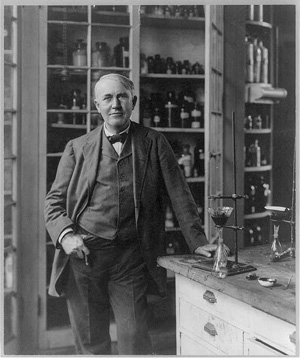
Edison was one of the first to grasp the importance of chemical knowledge when conducting industrial research and development. There was more chemical knowhow employed in the development of the incandescent electric light than there was knowledge of electricity and electrical engineering. Once the basic principle of the phonograph was discovered, the years of arduous work on its development by Edison and others dealt largely with the composition and handling of materials for records—again a chemical problem.”
—Byron M. Vanderbilt, Thomas Edison, Chemist, 1971
Menlo Park Laboratory
Until this time, Edison had relied upon various machinists’ shops and company workshops for research space and to produce his inventions. For a five-year period, Edison maintained workshops in Newark, New Jersey, but after the sale of the quadruplex telegraph (a system that allowed four messages to be sent simultaneously across one cable) in 1876 he was able to establish his own laboratory at Menlo Park, New Jersey. Here, only a short train ride from the commercial and manufacturing centers of Newark and New York, Edison sought to create a new kind of workspace for testing and developing his inventions.
The Menlo Park laboratory was itself a significant innovation and is considered the first modern industrial research laboratory. Here, in well-equipped machine shops and electrical and chemical laboratories, he employed skilled workers: machinists, electricians, chemists, and other scientific and technical employees. Within two years his staff numbered about 30 individuals who supported his sophisticated research. It was the nation’s largest private laboratory at the time.
The setup of the Menlo Park laboratory was especially suitable for invention and product development, and Edison’s lab was considered a model for modern research laboratories that soon became essential to corporate research. Its establishment marked the transition from individual research that dominated at this time to the organized, collaborative research that is prevalent today. Here Edison famously proclaimed he would turn out “a minor invention every ten days and a big thing every six months or so.”
Phonograph
Edison’s work in transmitting communication through the telegraph and telephone led to his first major invention: the phonograph. After investigating acoustic telegraphy and improvements to the telephone (invented by Alexander Graham Bell in 1876), Edison set as his next task the work of recording and reproducing sound. He recognized that if he could record sound vibrations via the carbon transmitter (an improvement to the telephone microphone that Edison had invented in 1877), it might be possible to play them back. His initial design used a grooved cylinder covered with tin foil, which received the vibrations and mechanically imprinted them into the grooves. To his astonishment, the device worked on the first attempt.
On December 7, 1877, Edison conducted the first demonstration of the machine before journalists in New York. Their reception was enthusiastic, and news of Edison’s “speaking phonograph” was widely distributed—people simply had not conceived of the idea of recording and replaying sound. Edison applied for a patent for the device in December, and received patent #200,521 on February 19, 1878, introducing the new age of recorded sound.
While the machine was a novelty that made national headlines, other inventions like the electrical light shifted Edison’s focus away from the phonograph. It would take another two decades until the machine would become the popular household entertainment device it is remembered as today.
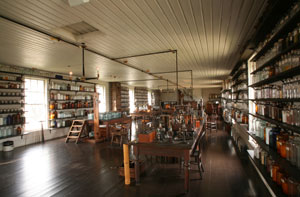
The setup of the Menlo Park laboratory was especially suitable for invention and product development, and Edison’s lab was considered a model for modern research laboratories that soon became essential to corporate research."
Light Bulb Filaments and Electrical Lighting
His next inventive turn after the introduction of the phonograph took an entirely different direction: an electric lighting system. In 1878, after conceiving of a system that could support electrical lighting, Edison began his research in earnest, seeking to develop a method of lighting that could replace candles, kerosene, and gas flames in homes, businesses, and public spaces.
Edison entered the field fully aware of the difficulties other inventors had encountered in developing a practical incandescent light bulb. An incandescent light bulb consists of a glass container with a filament through which an electrical current is passed. As electricity moves through the filament, the material produces heat and light. Edison searched for a filament material that could be pulled into a thread and inserted into a glass bulb. It required a high melting point, ductility, electrical conductance, and reliability. He started his experiments with platinum, an element known to have many of the necessary attributes, but physical and chemical analysis revealed that heating the metal in air caused cracks that resulted in failure.
Meanwhile, his team succeeded in creating a vacuum within a glass bulb. This solved the problem of heating the filament in air and opened the search to non-metal materials. Edison identified carbon as the most suitable material, and his team worked to produce an evacuated light bulb with a carbon-impregnated thread as the filament. The bulb lasted for more than 40 hours and was considered a major breakthrough. The experiment, concluded on October 21, 1879, is heralded as the birth of the electric light.
Research continued to find a more resilient and higher-voltage filament to improve the bulb’s lifespan, durability, and light output. Edison began a comprehensive test of all the carbon-based materials he could find. A bamboo sample taken from a ladies’ hand fan proved the best, due to the molecular structure of bamboo’s cellulose fibers. Edison’s light bulb with a bamboo-based carbon filament was introduced in 1880.
Bamboo remained Edison’s preferred filament for more than a decade, until it was replaced by carbon-impregnated rayon, a newly invented cellulose fiber, in 1892. This filament was used until 1906 when metals such as tungsten replaced carbon. For more than 100 years, the basic design of light bulbs followed Edison’s original 1879 invention, until incandescent bulbs were phased out in the U.S. in 2014 after the emergence of more energy-efficient designs.
Now having a working light bulb, Edison returned to New York to begin installing a system of electrical power and lighting. The project took teams dedicated to solving problems of electrical generation and transmission and factories to produce the light bulbs, insulated wires, fuses, and other necessary components. When installed in 1880, the project was an enormous success. The introduction of the electrical lighting system cemented Edison’s reputation as an inventive genius.
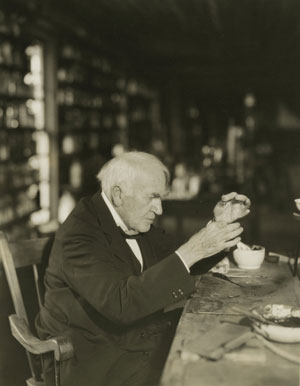
West Orange Laboratory
After the New York electrification project was completed, Edison looked forward to returning to New Jersey to invent. By this time Edison’s activities had outgrown the Menlo Park laboratories, and he sought a new, expanded location for his research and manufacturing operations. He selected West Orange, a community 30 miles closer to New York than Menlo Park, to establish his home and laboratory complex.
When completed in 1887, the West Orange complex was the most modern and well-equipped industrial research facility in the world. It included several specialty laboratories for electricity, physics, chemistry, and metallurgy, as well as chemical storage and a library of chemical information to support Edison’s expansive research. Over the next several decades as his inventions spawned industries, Edison established chemical manufacturing operations and factories nearby.
Phonograph Record Materials
The introduction of the phonograph led to a series of improvements to increase the device’s reliability, sound quality, and affordability. Much of Edison’s later work on the phonograph focused on improvements to record design—a question of material science.
Edison’s first improvement to the phonograph after the original tinfoil record was the development of wax cylinders into which recordings could be incised. These were introduced between 1888 and 1889. Other inventors preferred a flat disc to the cylinder, and the former won commercial success for its ease of production. Although the acoustical qualities of Edison’s wax records were superior to the plastic-based records used by competitors, the latter proved longer lasting—durability was an advantage in the era of musical records that were to be played using styluses made of iron or cactus barbs.
Edison accepted the disc design and turned to plastics in his search for the ideal phonograph record. Plastics are polymers that, when optimized in their chemical composition and properties, are moldable and durable. For applications such as phonograph records they offer substantial advantages over other materials. During this time, the plastics industry was rapidly emerging: celluloid, the first plastic made from plant material, was introduced in 1869; the first wholly synthetic plastic, Bakelite®, was produced in 1907.
Edison was aware of the current developments in these new materials, and his team experimented extensively with plastics and resins in their search for a durable record that could be mass-manufactured and produce high-quality sound. Condensite, a phenolic resin that is chemically similar to Bakelite and was invented by Edison’s team in 1910, was identified as a suitable disc material. Records made from condensite could be mass-produced, were highly durable, and provided superior sound.
Record manufacturing was one of the earliest uses for plastics and thus a major field for experimentation on both quality and mass production. The Edison Disc Phonograph of 1911 paired the condensite record with a diamond stylus that Edison invented to provide the highest-quality sound reproduction available at the time.
Electrical Storage Battery
When automobiles were introduced to U.S. consumers in the 1890s, electricity, steam, and petroleum-based fuels competed to power this new market. Edison, who was familiar with battery technology from his earliest days as a telegraph operator, favored battery power but disliked the standard lead-acid battery that was then used. In 1900 he set out to produce a superior version.
A battery is a device that converts chemical energy into electrical energy. The basic design is a two-chambered cell with positive- and negative-charged electrodes in an electrolyte solution through which the electrical charge is transmitted. The electrical output of the battery is largely determined by the materials used in its design.
At the time, Edison was producing a primary battery called the Lalande cell by the hundreds of thousands annually. Primary batteries produce electricity, but they cannot be recharged. Lalande cells were messy and required regular replacement of electrolytes. Edison sought a battery for automobiles that could be recharged by the energy generated during the vehicle’s operation (a design called a storage battery) and that was simpler for consumers to use. He experimented extensively with metals and electrolyte solutions to perfect his version of a rechargeable battery.
Edison’s invention, the nickel-iron alkaline electrical storage battery, implemented nickel as the positive electrode and iron as the negative. The approach required advances in purification of nickel metal and a new production method for iron powder. After extensive research and manufacturing tests, the Edison battery began sales in 1904. Early problems resulted in a temporary suspension of manufacturing, but Edison’s team of researchers scrutinized the faulty batteries that were returned by customers and devised a solution for the problems observed with the nickel plates in the original design.
When reintroduced in 1909, the improved Edison Storage Battery solved earlier problems of sustained electrical discharge and reliability in road tests. As Edison had envisioned, it was used primarily in small electrical vehicles, such as delivery vehicles in urban areas, although it was not adopted widely for automobile design.
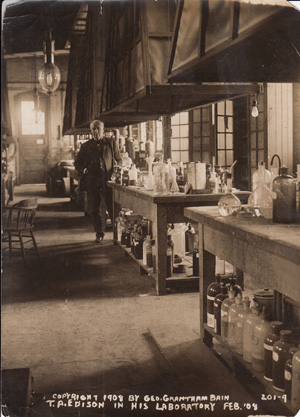
I will have the best equipped and largest laboratory extant, and the facilitiesincomparably superior to any other for rapid and cheap development of an invention,and working it up into commercial shape with models, patterns and special machinery.In fact, there is no similar institution in existence.”
—Thomas A. Edison, in a letter to J. Hood Wright, 1887
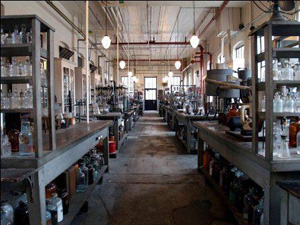
Development of Synthetic Plastics
Learn more about the development of synthetic plastics by reading about the Leo Hendrick Baekeland and the Invention of Bakelite® National Historic Chemical Landmark.
Rubber and the Edison Botanic Research Corporation
Edison was involved with organic chemical production and military preparation during World War I, a time when the nation’s civilians, businesses, and armed forces struggled with shortages of important strategic materials. Having been recruited as a naval research advisor during the war, Edison was at the forefront of the nation’s leadership in wartime preparations. From this position, he recognized the important need for finding a domestic source for rubber, a material that was essential to automobile production and many other uses. As early as 1923 Edison began to experiment in this field.
Edison used rubber in his electrical storage batteries and was close friends with Henry Ford and Harvey Firestone, both of whose businesses were closely tied to rubber. His background in business and materials science made him uniquely qualified to lead the endeavor. In 1927 he joined with Ford and Firestone to establish the Edison Botanic Research Corporation at his winter home in Fort Myers, Florida. The following year Edison completed his botanic laboratory in Fort Myers.
At this time, all rubber was produced from natural sources—in particular the latex of Hevea trees—and the vast majority was imported from plantations in Southeast Asia. Edison set out to identify a source of rubber that could be produced domestically from plants that could be grown quickly in the U.S. if imports were cut off during wartime. He was aware of past surveys of native plants to identify their rubber content, but he believed that a larger, more systematic survey might identify a new source of rubber.
He invited botanists from New Jersey to Florida to send samples of local plants to his botanical laboratory for analysis. The process involved grinding the plant material and chemically processing it to determine each sample’s rubber content. As the project grew, more than 17,000 plant samples from around the world were analyzed for their rubber content, and one group of plants—Solidago, commonly known as goldenrod—was selected as the most promising due to both its high rubber content and ability to be grown quickly in the U.S.
Edison’s team crossbred species of goldenrod to increase their rubber content, and tested industrial production. After his death on October 18, 1931, the project continued for five years until it was transferred to the U.S. Department of Agriculture. Edison’s plans to grow rubber from goldenrod domestically never came to fruition (scientists developed a synthetic process for rubber production during World War II), but the project nonetheless represents a major advance in modern research on producing materials from renewable resources.
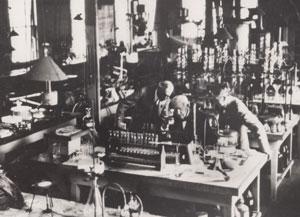
Rubber During WWII
Learn more about the development of synthetic rubber in the U.S. during World War II by reading about the U.S. Synthetic Rubber Program National Historic Chemical Landmark.
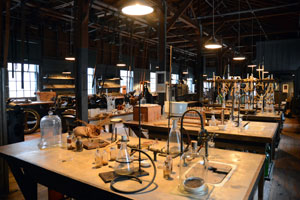
Thomas Edison's Legacy
Edison’s inventive mind encompassed all manner of American life, from consumer products to strategic materials and war preparations. While popularly regarded as an inventor, Edison was an able applied chemist whose numerous inventions and businesses were enabled by his chemical knowledge.
Through experimentation and with skilled scientific and technical teams working in his modern and sophisticated laboratories, Thomas Edison, the chemist, is remembered for inventions that improved the standard of living and impacted all manner of life for Americans in the 20th century.
Further Reading
- Edison Biography (Thomas Edison National Historical Park, National Park Service, U.S. Department of the Interior)
- Edison's Menlo Park Complex (The Henry Ford, Greenfield Village)
- Edison Botanic Research Laboratory (Edison & Ford Winter Estates)
- History (Thomas Edison Center at Menlo Park)
- B. M. Vanderbilt (1971) Thomas Edison, Chemist. Washington, D.C., American Chemical Society.
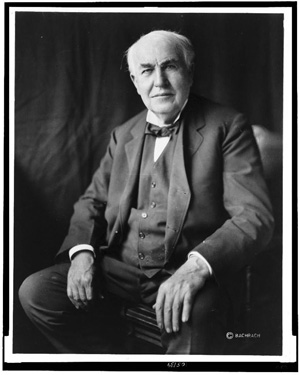
Dedication and Acknowledgments
Landmark Dedication
The American Chemical Society dedicated Thomas Edison's work in chemistry as a National Historic Chemical Landmark in ceremonies at the Edison & Ford Winter Estates in Fort Myers, Fla., on May 25, 2014; at the Thomas Edison National Historical Park in West Orange, N.J., on June 6, 2014; at The Henry Ford, Greenfield Village, in Dearborn, Mich., on Sept. 20, 2014; and at the Thomas Edison Center at Menlo Park in Edison, N.J., on Oct. 24, 2015.
The commemorative plaque at the Edison & Ford Winter Estates reads
In 1927 Thomas Edison joined with Henry Ford and Harvey Firestone to establish the Edison Botanic Research Corporation to investigate a source of rubber that could be produced domestically. Edison’s background in materials science and business made him uniquely qualified to lead the search for this critically important material. The following year, Edison built this botanical laboratory where more than 17,000 plant samples from around the world were analyzed for their latex content. One group of plants—Solidago, commonly known as goldenrod—was selected as the most promising. Edison’s team crossbred species to increase their rubber content, and tested industrial production. When Edison died in 1931 the rubber project continued for five years until it was transferred to the U.S. Department of Agriculture.
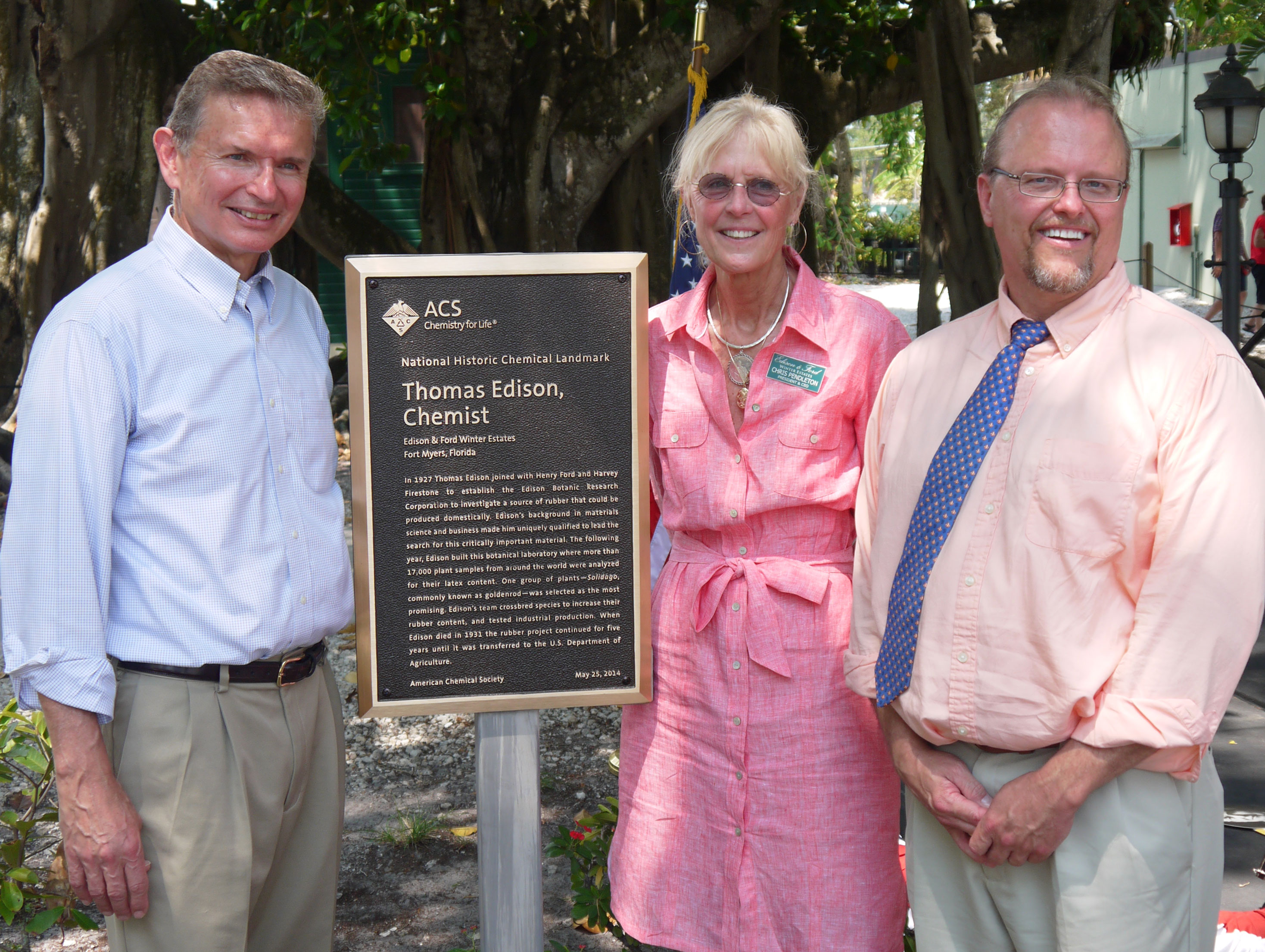
The commemorative plaque at the Thomas Edison National Historical Park reads
Thomas Edison developed an interest in chemistry at a young age, and applications of chemistry were a common theme in many of his inventions. Edison opened his West Orange, N.J., laboratory complex in 1887 as an expanded site for research and product development. The complex was among the most modern and well-equipped industrial research facilities in the world with a chemical laboratory and library of chemical information to support Edison’s expansive research, chemical manufacturing operations, and factories to produce Edison’s inventions. Chemical developments originating from the West Orange laboratory included plastics and waxes for disc and cylinder phonograph records, nickel-iron alkaline electric storage batteries, and improvements to the manufacture of Portland cement.
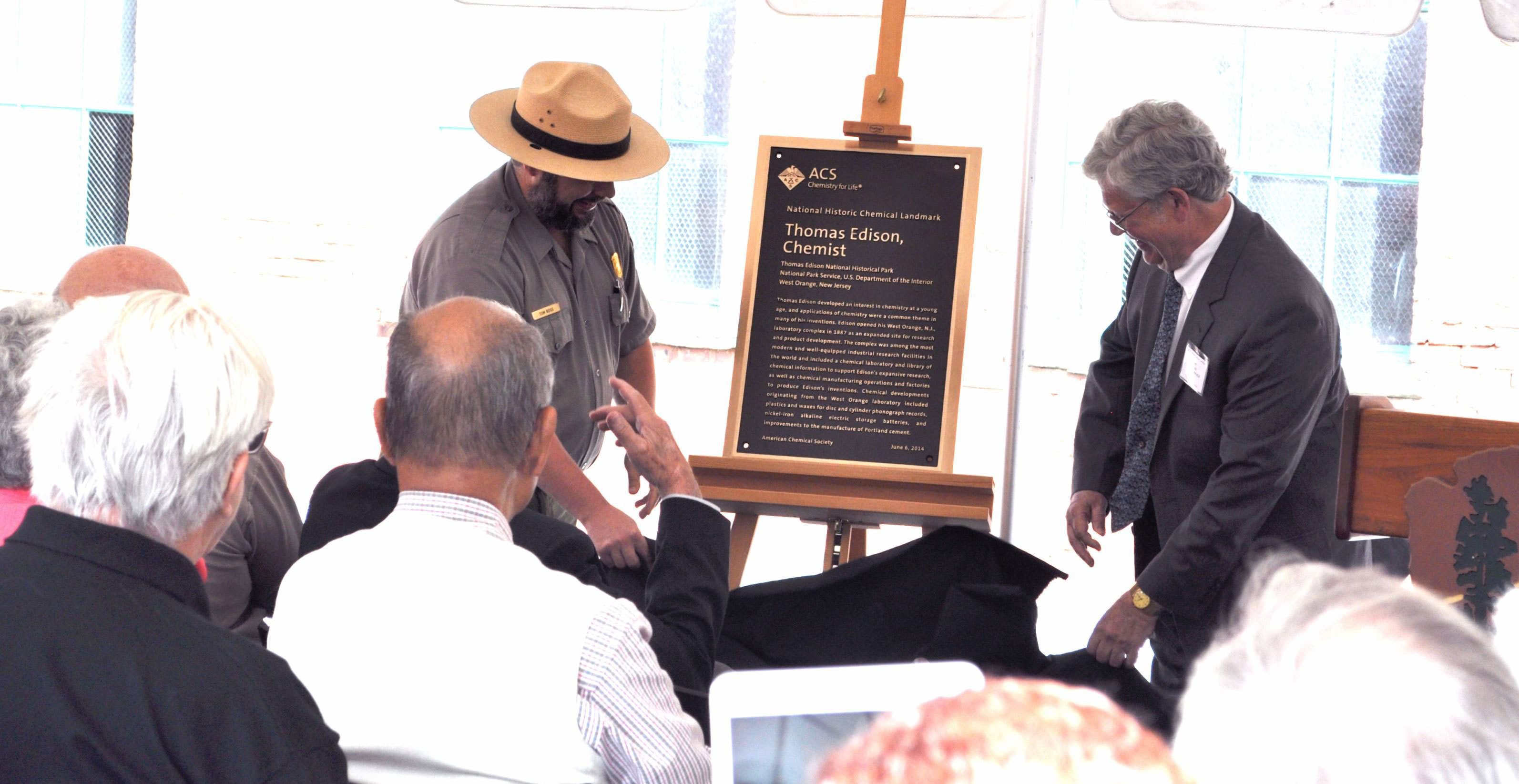
The commemorative plaque at The Henry Ford, Greenfield Village, reads
Thomas Edison developed an interest in chemistry as a young boy while growing up in Michigan, and applications of chemistry were a common theme in many of his inventions. In 1876 Edison opened the nation’s largest private laboratory in Menlo Park, N.J., for invention, research, and product development. Here he employed machinists, electricians, chemists, and other scientific and technical workers in well-equipped machine shops and electrical and chemical laboratories. At Menlo Park Edison led a comprehensive survey of filament materials, selecting carbonized bamboo for his first commercial electric light bulb. In 1928 the Menlo Park buildings were moved from their original site in New Jersey to Dearborn where they were reconstructed by Edison’s friend Henry Ford.
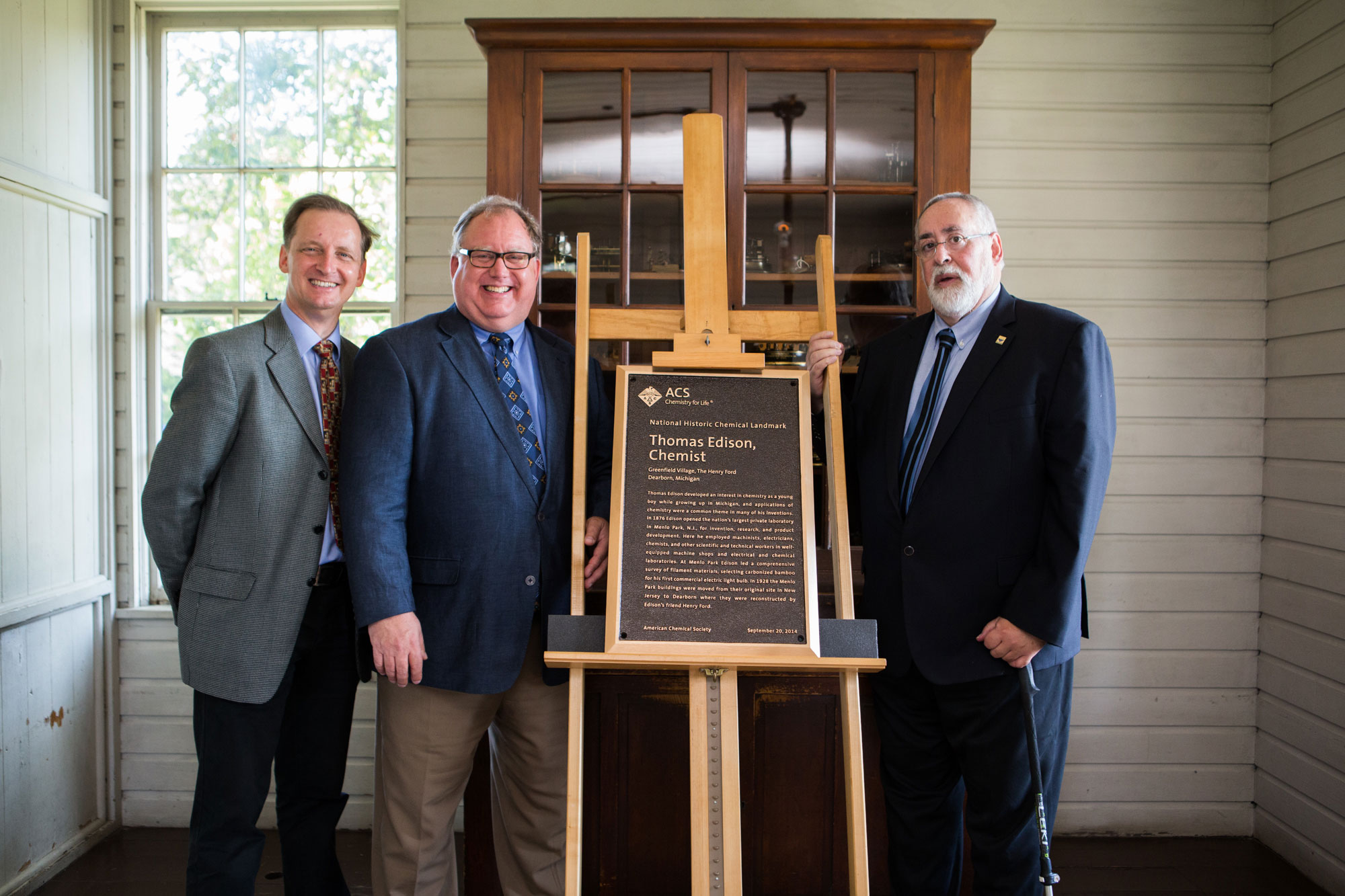
The commemorative plaque at the Thomas Edison Center at Menlo Park reads
Thomas Edison developed an interest in chemistry as a young boy while growing up in Michigan, and applications of chemistry were a common theme in many of his inventions. In 1876 Edison opened the nation’s largest private laboratory in Menlo Park, N.J., for invention, research, and product development. Here he employed machinists, electricians, chemists, and other scientific and technical workers in well-equipped machine shops and electrical and chemical laboratories. At Menlo Park Edison led a comprehensive survey of filament materials, selecting carbonized bamboo for his first commercial electric light bulb.
Acknowledgments
Adapted for the internet from “Thomas Edison, Chemist” produced by the National Historic Chemical Landmarks program of the American Chemical Society in 2014.
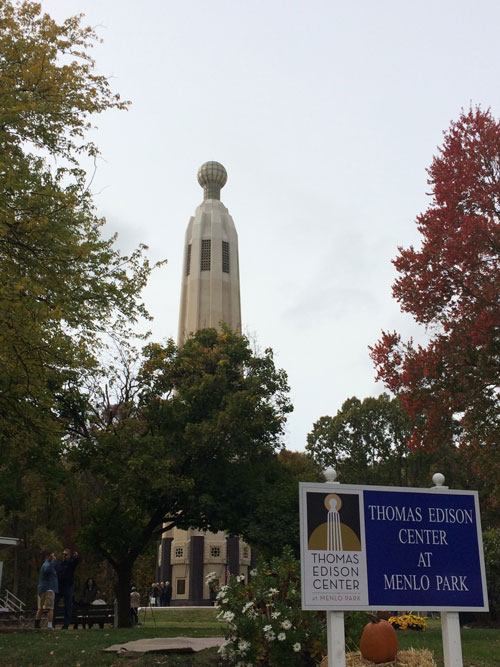
Back to National Historic Chemical Landmarks Main Page.
Learn more: About the Landmarks Program.
Take action: Nominate a Landmark and Contact the NHCL Coordinator.

